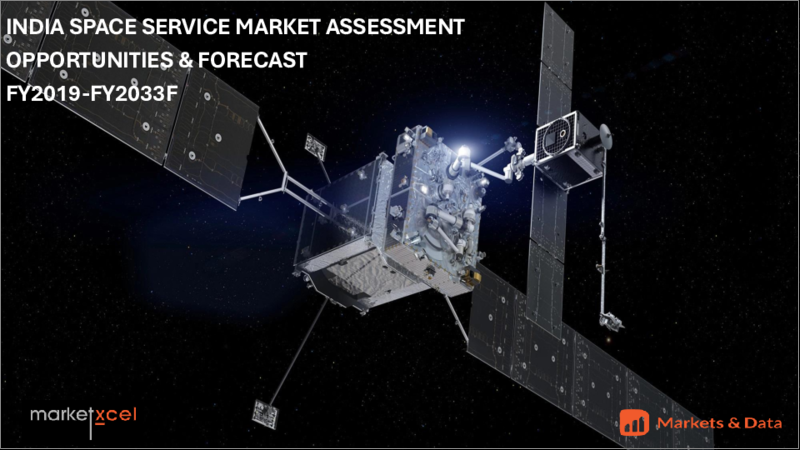|
|
市場調査レポート
商品コード
1716736
インドの宇宙サービス市場:サービス別、用途別、地域別、機会、予測、2019年~2033年India Space Service Market Assessment, By Service, By Application, Region, Opportunities and Forecast, FY2019-FY2033F |
||||||
カスタマイズ可能
|
|||||||
| インドの宇宙サービス市場:サービス別、用途別、地域別、機会、予測、2019年~2033年 |
|
出版日: 2025年05月01日
発行: Markets & Data
ページ情報: 英文 131 Pages
納期: 3~5営業日
|
全表示
- 概要
- 図表
- 目次
インドの宇宙サービスの市場規模は、2026年~2033年の予測期間中に15.22%のCAGRで拡大し、2025年の23億8,000万米ドルから2033年には73億8,000万米ドルに成長すると予測されています。インドの宇宙サービス市場は、民間セクターの参入を促す革新的な政策と技術の進歩に後押しされ、大きな変貌を遂げています。政府機関は、官民間の協力環境を構築し、インドを世界な舞台における競合国として位置づけています。この戦略的転換は、衛星配備と宇宙利用サービスの能力強化に重点を置き、活力ある宇宙経済への道を開くものです。地域的には、南インドのカルナータカ州とタミル・ナードゥ州が飛躍的成長の拠点となりつつあります。この地域には、インド宇宙研究機構のようなベンガルールのトップ機関が支援する航空宇宙・防衛企業の活気あるエコシステムがあります。このような専門知識とリソースの集中は、多くのイノベーションを推進し、それによって革新的な宇宙技術の開発ペースを速めることができます。打上げロケットを製造・提供する民間企業の出現は、競争力のある安価な衛星打上げサービスへの成長を示しています。これは、衛星配備による膨大な宇宙需要を満たすだけでなく、インドの能力を拡大するものです。これにより、民間企業が市場に参入することで、各企業はより効率的に事業を展開し、コストを削減するとともに、宇宙分野における世界の存在としてインドをさらに確立することができます。
例えば、2024年10月、インド宇宙研究機関(ISRO)は、宇宙観光ミッション用に特別に設計された最先端の再利用可能なロケットとカプセルシステムを導入しました。この革新的なシステムは、乗客を高度100kmまで運び、総飛行時間約8.5分の間に約3.5分の無重力状態を提供するよう設計されています。この開発は、インドの商業宇宙能力を強化し、宇宙観光を経済的に利用しやすくするというISROの戦略的ビジョンに沿ったものです。さらにISROは、衛星の展開、有人宇宙飛行、2035年までに計画されているインドの宇宙ステーションの支援、2040年までに計画されている有人月探査など、多様なミッションを想定した3段式の部分再使用可能な重量物運搬船である次世代ロケット(NGLV)の開発を進めています。
当レポートでは、インドの宇宙サービス市場について調査し、市場の概要とともに、サービス別、用途別、地域別動向、および市場に参入する企業のプロファイルなどを提供しています。
目次
第1章 プロジェクトの範囲と定義
第2章 調査手法
第3章 米国の関税の影響
第4章 エグゼクティブサマリー
第5章 お客様の声
第6章 インドの宇宙サービス市場の見通し、2019年~2033年
- 市場規模分析と予測
- 市場シェア分析と予測
- サービス別
- 打ち上げロケットサービス
- 衛星製造
- 地上サービス
- データサービス
- コンサルティングおよびサポートサービス
- その他
- 用途別
- 地球観測とリモートセンシング
- 通信サービス
- ナビゲーションとポジショニング
- 宇宙調査
- 防衛と安全保障
- 地域別
- 北部
- 南部
- 東部
- 西部と中央部
- 企業別市場シェア分析(上位5社およびその他- 金額ベース、2025年)
- サービス別
- 2025年の市場マップ分析
第7章 バリューチェーン分析
第8章 ポーターのファイブフォース分析
第9章 PESTLE分析
第10章 市場力学
- 市場の促進要因
- 市場の課題
第11章 市場動向と発展
第12章 ケーススタディ
第13章 競合情勢
- 市場リーダートップ5の競合マトリックス
- 参入企業トップ5のSWOT分析
- 市場の主要企業トップ10の情勢
- Digantara Research and Technologies Private Limited
- Skyroot Aerospace Private Limited
- Agnikul Cosmos Private Limited
- Bellatrix Aerospace Pvt. Ltd
- Dhruva Space Private Limited
- Pixxel Space Technologies, Inc
- Ananth Technologies PVT. LTD.
- Data Pattern (India) Ltd.
- Larsen & Toubro Limited
- Antrix Corporation Limited
第14章 戦略的提言
第15章 調査会社について・免責事項
List of Tables
- Table 1. Competition Matrix of Top 5 Market Leaders
- Table 2. Mergers & Acquisitions/ Joint Ventures (If Applicable)
- Table 3. About Us - Regions and Countries Where We Have Executed Client Projects
List of Figures
- Figure 1. India Space Service Market, By Value, In USD Billion, FY2019-FY2033F
- Figure 2. India Space Service Market Share (%), By Service, FY2019-FY2033F
- Figure 3. India Space Service Market Share (%), By Application, FY2019-FY2033F
- Figure 4. India Space Service Market Share (%), By Region, FY2019-FY2033F
- Figure 5. By Service Map-Market Size (USD Billion) & Growth Rate (%), FY2025
- Figure 6. By Application Map-Market Size (USD Billion) & Growth Rate (%), FY2025
- Figure 7. By Region Map-Market Size (USD Billion) & Growth Rate (%), FY2025
India space service market is projected to witness a CAGR of 15.22% during the forecast period FY2026-FY2033, growing from USD 2.38 billion in FY2025 to USD 7.38 billion in FY2033. The space service market in India is witnessing a significant transformation, driven by innovative policies and technological advancements that encourage private sector participation. The government agencies have created a collaborative environment between public and private entities, positioning India as a competitive player on the global stage. This strategic shift focuses on enhancing capabilities in satellite deployment and space-enabled services, paving the way for a vibrant space economy. Regionally, Karnataka and Tamil Nadu in Southern India are becoming a hub for exponential growth. The region has a vibrant ecosystem of aerospace and defense enterprises supported by top Bengaluru institutions such as the Indian Space Research Organization. The presence of such concentrations of expertise and resources can drive much innovation and thereby quicken the pace of developing innovative space technologies. The emergence of private players that build and provide launch vehicles shows growth toward competitive and affordable satellite launch services. This expands on India's capabilities besides fulfilling the vast demand in space due to satellite deployment. Thereby, with private players entering the market, each one operates more efficiently and drives down costs while further establishing India as a global entity in the space arena.
For instance, in October 2024, The Indian Space Research Organisation (ISRO) introduced a cutting-edge reusable rocket and capsule system specifically designed for space tourism missions. This innovative system is engineered to transport passengers to an altitude of 100 kilometers, providing them with approximately 3.5 minutes of weightlessness during a total flight duration of around 8.5 minutes. The development aligns with ISRO's strategic vision to enhance India's commercial space capabilities and make space tourism more economically accessible. Additionally, ISRO is progressing with its Next Generation Launch Vehicle (NGLV), a three-stage, partially reusable heavy-lift vehicle intended for diverse missions, including satellite deployment, human spaceflight, and supporting India's planned space station by 2035 and crewed lunar mission by 2040.
Navigation and Mapping Drives the Market
Improved navigation and mapping services are major drivers for India's growing space service market as demand escalates for more authentic and elaborative digital maps. The government's increase in investments in infrastructure and smart cities demands reliable mapping solutions, especially in transportation, logistics, and urban planning applications where accuracy is important. Increasing application of location-based services and the rise of more ride-hailing and delivery further drive requirements for real-time navigation solutions; further advancements also enhance GIS capacity in agriculture, environmental monitoring, and other areas; as such, it continues to provide an impetus for growth on the Indian side.
For instance, in July 2024, Dhruva Space Private Limited obtained official authorization from IN-SPACe to deliver Ground Stations as a Service (GSaaS). This service guarantees dependable data transmission, increases mission adaptability, and lowers operational expenses for ground station activities. GSaaS facilities located in equatorial regions, particularly those supporting low Earth inclination orbits, provide extended satellite visibility periods, decreased communication delays, and improved signal dependability owing to reduced atmospheric disturbances. These strategically positioned, cost-efficient stations are optimized to enhance global satellite operations across various applications, including telecommunications and remote sensing, while also offering valuable support for launch vehicle tracking activities, leveraging India's advantageous geographic position.
Satellite-based Internet Fuels the Demand
Satellite-based internet fuels the Indian space service market, and this helps bridge the digital divide in rural and underserved areas. Traditional internet infrastructure simply cannot adequately serve these regions, and that is where satellite-based connectivity comes in as a ready and scalable solution. The government's focus on digital inclusion fits well with the increasing requirement for reliable internet access to allow communities in all regions to unlock critical services like education, healthcare, and e-commerce. Partnerships among satellite operators and local telecom companies are facilitating inroads. In contrast, technical improvements in Low Earth Orbit (LEO) satellites are cutting down latency and providing faster speeds, thus better performance.
For instance, in January 2024, The Indian National Space Promotion and Authorisation Centre (IN-SPACe) is anticipated to grant necessary clearances to Reliance Jio, enabling the company to introduce satellite-based broadband services across India. Upon receiving these approvals, Reliance Jio will achieve the distinction of becoming the nation's inaugural provider of satellite internet services, marking a significant milestone in India's digital connectivity landscape and expanding broadband access to remote regions across the country.
Inclusion of Space Technology in Agriculture Bolster the Demand
Including space technology in agriculture is significantly improving the demand for advanced agricultural practices in India. Farmers are given timely and unbiased information regarding crop conditions, soil health, and weather conditions through satellite data. This helps in monitoring activities in agriculture, which allows the farmer to make better decisions concerning irrigation, fertilization, and pest control. Initiatives such as the Forecasting Agricultural Output using Space, Agro-meteorology, and Land-based Observations (FASAL) project are excellent examples of the use of satellite imagery in augmenting crop production forecasting and resource management. Furthermore, the government is launching satellites for remote sensing capabilities to get an effective assessment of drought and mapping of land usage, which becomes critical for optimizing agricultural output.
For instance, in July 2024, Cropin Technology, an AI Platform for food and agriculture, announced the launch of Sage, a real-time agri-intelligence solution. This innovation by the company converts global agricultural terrain into specialized grid-based maps, offering customizable resolution options of 3x3 meters, 10x10 meters, or 5x5 kilometers. This sophisticated platform delivers comprehensive agricultural data and intelligence with exceptional precision, extensive coverage, and rapid processing capabilities, revolutionizing how farming data is collected and analyzed worldwide.
Launch Services Lead the India Space Service Market
The launch services segment is a leading sector of India space service market, fueled by a high demand for satellite deployments. With the rise of private companies, there is a significant focus on small satellite launches, which are very much preferred these days for their cost-effectiveness and rapid turnaround times. The Indian Space Research Organization (ISRO) has also developed new launch vehicles specific to this category, which is further increasing competition and innovation. This trend is complemented by the government's policies encouraging private sector participation and investment in space technology. Increased collaboration between public and private entities further propels advancements in launch capabilities, making India a key player in the global launch services arena.
For instance, in October 2024, Indian space startup Skyroot Aerospace publicly showcased its domestically developed Vikram-1 launch vehicle, designed to transport small satellites to low Earth orbit. The company simultaneously inaugurated its new corporate facility named 'The MAX-Q Campus' located at the GMR Aerospace and Industrial Park in Mamidipally, South Hyderabad, marking a significant expansion of its operational capabilities.
Southern India Dominates the Market
The space service market in the country is emerging to be dominated by Southern India, primarily because of the concentration of expertise and resources in states such as Karnataka and Tamil Nadu. This region houses a robust ecosystem of aerospace and defense industries, with Bengaluru being a hub for innovation, primarily driven by private players. Leading educational institutions and research centers around the region further augment the space technology development capabilities. Supportive policies and initiatives pursued by the government have also created an environment to allow the private sector to operate freely, thereby promoting the growth of startups and established companies. This collaborative landscape becomes critical for taking satellite technology and launch services to the growth trajectory, cementing the position of Southern India at the heart of Indian space ambitions.
For instance, in December 2024, the Union Ministry of Science & Technology announced financial and technical support for Chennai-based Agnikul Cosmos Private Limited to finalize development and begin commercialization of their Agnibaan launch vehicle. This versatile two-stage rocket can accommodate payloads weighing up to 300 kg for orbits at 700 km altitude, featuring several innovative advantages including: dedicated and scalable launch options for payloads ranging from 30 to 300 kg; remarkably short satellite integration timelines of just two weeks; adaptable mobile launch platforms that can operate from various global locations; and mission customization capabilities that address the limitations of conventional rideshare launch arrangements.
Future Market Scenario (FY2026-FY2033F)
The Indian space service market is poised for substantial growth, driven by government reforms and increased private sector participation, enabling innovative technologies and services.
Strengthened public-private partnerships will play a crucial role in advancing space missions, with private firms increasingly involved in satellite manufacturing and launch services.
A surge in space startups is expected to enhance India's capabilities in satellite technology and services, contributing to a more competitive landscape in the global space economy.
The upcoming expansion of satellite constellations will improve capabilities in Earth observation and data analytics, benefiting various sectors such as agriculture, infrastructure, and urban planning.
Key Players Landscape and Outlook
The competitive landscape of India's space service market is characterized by a dynamic interplay between established companies and a burgeoning private sector. The Indian Space Research Organisation (ISRO) continues to lead with its cost-effective launch capabilities and successful missions, setting high standards for reliability and innovation. Emerging private players are increasingly entering the market, focusing on developing reusable launch vehicles and advanced satellite technologies to enhance operational efficiency. The government's support through initiatives like IN-SPACe fosters collaboration between public and private sectors, creating a conducive environment for innovation. However, challenges such as reliance on imported components and the need for a skilled workforce persist, highlighting the importance of building a robust domestic supply chain to ensure sustainable growth in this competitive arena.
For instance, in May 2024, Spacetech firm Digantara Research and Technologies Private Limited, specializing in space situational awareness (SSA), was chosen to participate in the landmark Mission for Australia-India's Technology, Research, and Innovation (Maitri). This collaborative industry initiative is spearheaded by Space Machines Company and backed by substantial funding exceeding USD 5.6 million (AUD 8.5 million) from the Australian Space Agency through its International Space Investment (ISI) India Projects programme.
Table of Contents
1. Project Scope and Definitions
2. Research Methodology
3. Impact of U.S. Tariffs
4. Executive Summary
5. Voice of Customers
- 5.1. Factors Considered in Purchase Decisions
- 5.1.1. Mission Requirements and Objectives
- 5.1.2. Technical Capabilities and Expertise of Providers
- 5.1.3. Service Cost and Budget
- 5.2. Consideration of Regulations
6. India Space Service Market Outlook, FY2019-FY2033F
- 6.1. Market Size Analysis & Forecast
- 6.1.1. By Value
- 6.2. Market Share Analysis & Forecast
- 6.2.1. By Service
- 6.2.1.1. Launch Vehicle Services
- 6.2.1.2. Satellite Manufacturing
- 6.2.1.3. Ground Services
- 6.2.1.4. Data Services
- 6.2.1.5. Consulting and Support Services
- 6.2.1.6. Others
- 6.2.2. By Application
- 6.2.2.1. Earth Observation and Remote Sensing
- 6.2.2.2. Communication Services
- 6.2.2.3. Navigation and Positioning
- 6.2.2.4. Space Research
- 6.2.2.5. Defense and Security
- 6.2.3. By Region
- 6.2.3.1. North
- 6.2.3.2. South
- 6.2.3.3. East
- 6.2.3.4. West and Central
- 6.2.4. By Company Market Share Analysis (Top 5 Companies and Others - By Value, FY2025)
- 6.2.1. By Service
- 6.3. Market Map Analysis, FY2025
- 6.3.1. By Service
- 6.3.2. By Application
- 6.3.3. By Region
7. Value Chain Analysis
8. Porter's Five Forces Analysis
9. PESTLE Analysis
10. Market Dynamics
- 10.1. Market Drivers
- 10.2. Market Challenges
11. Market Trends and Developments
12. Case Studies
13. Competitive Landscape
- 13.1. Competition Matrix of Top 5 Market Leaders
- 13.2. SWOT Analysis for Top 5 Players
- 13.3. Key Players Landscape for Top 10 Market Players
- 13.3.1. Digantara Research and Technologies Private Limited
- 13.3.1.1. Company Details
- 13.3.1.2. Key Management Personnel
- 13.3.1.3. Products and Services
- 13.3.1.4. Financials (As Reported)
- 13.3.1.5. Key Market Focus and Geographical Presence
- 13.3.1.6. Recent Developments/Collaborations/Partnerships/Mergers and Acquisitions
- 13.3.2. Skyroot Aerospace Private Limited
- 13.3.3. Agnikul Cosmos Private Limited
- 13.3.4. Bellatrix Aerospace Pvt. Ltd
- 13.3.5. Dhruva Space Private Limited
- 13.3.6. Pixxel Space Technologies, Inc
- 13.3.7. Ananth Technologies PVT. LTD.
- 13.3.8. Data Pattern (India) Ltd.
- 13.3.9. Larsen & Toubro Limited
- 13.3.10. Antrix Corporation Limited
- 13.3.1. Digantara Research and Technologies Private Limited
Companies mentioned above DO NOT hold any order as per market share and can be changed as per information available during research work.






